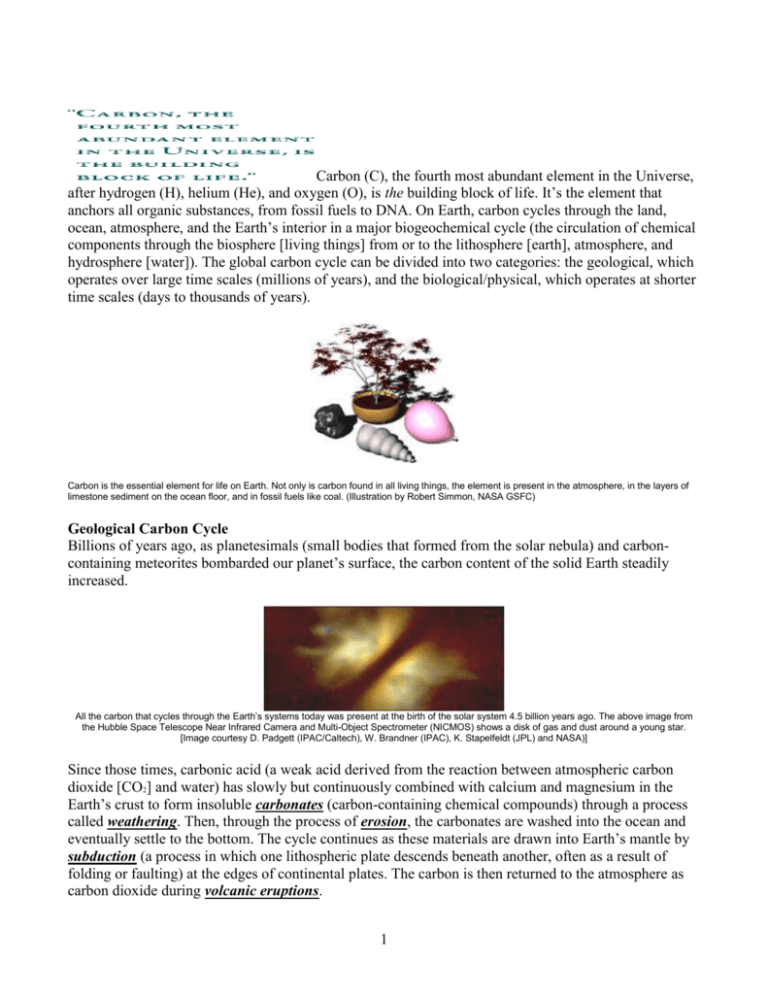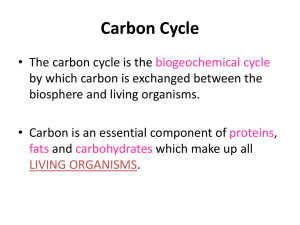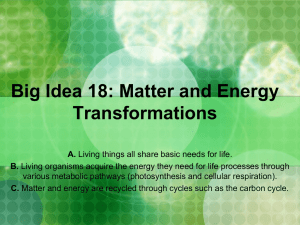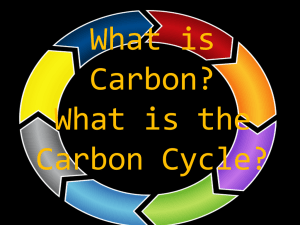global carbon cycle
advertisement

Carbon (C), the fourth most abundant element in the Universe, after hydrogen (H), helium (He), and oxygen (O), is the building block of life. It’s the element that anchors all organic substances, from fossil fuels to DNA. On Earth, carbon cycles through the land, ocean, atmosphere, and the Earth’s interior in a major biogeochemical cycle (the circulation of chemical components through the biosphere [living things] from or to the lithosphere [earth], atmosphere, and hydrosphere [water]). The global carbon cycle can be divided into two categories: the geological, which operates over large time scales (millions of years), and the biological/physical, which operates at shorter time scales (days to thousands of years). Carbon is the essential element for life on Earth. Not only is carbon found in all living things, the element is present in the atmosphere, in the layers of limestone sediment on the ocean floor, and in fossil fuels like coal. (Illustration by Robert Simmon, NASA GSFC) Geological Carbon Cycle Billions of years ago, as planetesimals (small bodies that formed from the solar nebula) and carboncontaining meteorites bombarded our planet’s surface, the carbon content of the solid Earth steadily increased. All the carbon that cycles through the Earth’s systems today was present at the birth of the solar system 4.5 billion years ago. The above image from the Hubble Space Telescope Near Infrared Camera and Multi-Object Spectrometer (NICMOS) shows a disk of gas and dust around a young star. [Image courtesy D. Padgett (IPAC/Caltech), W. Brandner (IPAC), K. Stapelfeldt (JPL) and NASA)] Since those times, carbonic acid (a weak acid derived from the reaction between atmospheric carbon dioxide [CO2] and water) has slowly but continuously combined with calcium and magnesium in the Earth’s crust to form insoluble carbonates (carbon-containing chemical compounds) through a process called weathering. Then, through the process of erosion, the carbonates are washed into the ocean and eventually settle to the bottom. The cycle continues as these materials are drawn into Earth’s mantle by subduction (a process in which one lithospheric plate descends beneath another, often as a result of folding or faulting) at the edges of continental plates. The carbon is then returned to the atmosphere as carbon dioxide during volcanic eruptions. 1 In the geological carbon cycle, carbon moves between rocks and minerals, seawater, and the atmosphere. Carbon dioxide in the atmosphere reacts with some minerals to form the mineral calcium carbonate (limestone). This mineral is then dissolved by rainwater and carried to the oceans. Once there, it can form layers of sediment on the sea floor. As the Earth’s plates move, through the processes of plate tectonics, these sediments are subducted underneath the continents. Under the great heat and pressure far below the Earth’s surface, the limestone melts and reacts with other minerals, releasing carbon dioxide. The carbon dioxide is then re-emitted into the atmosphere through volcanic eruptions. (Illustration by Robert Simmon, NASA GSFC) The balance between weathering, subduction, and volcanism controls atmospheric carbon dioxide concentrations over time periods of hundreds of millions of years. Biological/Physical Carbon Cycle: Photosynthesis and Respiration Biology also plays an important role in the movement of carbon in and out of the land and ocean through the processes of photosynthesis and respiration. Nearly all forms of life on Earth depend on the production of sugars from solar energy and carbon dioxide (photosynthesis) and the metabolism (respiration) of those sugars to produce the chemical energy that facilitates growth and reproduction. Through the process of photosynthesis, green plants absorb solar energy and remove carbon dioxide from the atmosphere to produce carbohydrates (sugars). Plants and animals effectively “burn” these carbohydrates (and other products derived from them) through the process of respiration, the reverse of photosynthesis. Respiration releases the energy contained in sugars for use in metabolism and renders the carbohydrate “fuel” back to carbon dioxide. Photosynthesis: 6 H2O + 6 CO2 + solar energy CH2O (sugars) + 6 O2 Respiration (& Decomposition): CH2O (sugars) + 6 O2 6 CO2 + 6 H2O + energy (heat, etc.) During photosynthesis, plants absorb carbon dioxide, water and sunlight to create fuel—glucose and other sugars—for building plant structures. This process forms the foundation of the biological carbon cycle. (Illustration courtesy P.J. Sellers et al.) Together, respiration and decomposition return the carbon back to the atmosphere. Photosynthesis and respiration also play an important role in the long-term geological cycling of carbon. Land vegetation takes-up carbon dioxide from the atmosphere. In the oceans, some of the carbon taken up by phytoplankton (microscopic marine plants that form the basis of the marine food chain) to make shells of calcium carbonate (CaCO3) settles to the bottom (after they die) to form sediments (limestone & marble). During times when photosynthesis exceeded respiration, organic matter slowly built up over 2 millions of years to form coal and oil deposits. All of these biologically mediated processes represent a removal of carbon dioxide from the atmosphere and storage of carbon in geologic sediments. Carbon on the Land and in the Oceans: The modern carbon cycle On land, the major exchange of carbon with the atmosphere results from photosynthesis and respiration. During the daytime in the growing season, leaves absorb sunlight and take up carbon dioxide from the atmosphere. At the same time, plants, animals and soil microbes consume the carbon in organic matter and return carbon dioxide to the atmosphere. Over the course of a year, these movements of carbon are over ten times greater than the amount of carbon introduced to the atmosphere by fossil fuel burning. Carbon Dioxide in the atmosphere has been steadily rising since regular measurements began in 1958. The graph above shows both the long-term trend and the seasonal variation. (Graph by Robert Simmon, based on data from the NOAA Climate Monitoring & Diagnostics Laboratory) Fire [COMBUSTION] also plays an important role in the transfer of carbon dioxide from the land to the atmosphere. Fires consume biomass and organic matter to produce carbon dioxide (along with methane, carbon monoxide, smoke), and the vegetation that is killed but not consumed by the fire decomposes over time adding further carbon dioxide to the atmosphere. Over periods of years to decades, significant amounts of carbon can be stored or released on land. For example, when forests are cleared for agriculture the carbon contained in the living material and soil is released, causing atmospheric carbon dioxide concentrations to increase. When agricultural land is abandoned and forests are allowed to re-grow, carbon is stored in the accumulating living biomass and soils causing atmospheric carbon dioxide concentrations to decrease. In the oceans, carbon dioxide exchange is largely controlled by sea surface temperatures, circulating currents, and by the biological processes of photosynthesis and respiration. Carbon dioxide can dissolve easily into the ocean and the amount of carbon dioxide that the ocean can hold depends on ocean temperature and the amount of carbon dioxide already present. Cold ocean temperatures favor the uptake of carbon dioxide from the atmosphere whereas warm temperatures can cause the ocean surface to release carbon dioxide. Cold, downward moving currents such as those that occur over the North Atlantic absorb carbon dioxide and transfer it to the deep ocean. Upward moving currents such as those in the tropics bring carbon dioxide up from depth and release it to the atmosphere. 3 The above image shows the global biosphere. The Normalized Difference Vegetation Index measures the amount and health of plants on land, while chlorophyll a measurements indicate the amount of phytoplankton in the ocean. Land vegetation and phytoplankton both consume atmospheric carbon dioxide. (Image courtesy the SeaWiFS Project, NASA/Goddard Space Flight Center, and ORBIMAGE) Life in the ocean consumes and releases huge quantities of carbon dioxide. But in contrast to land, carbon cycles between photosynthesis and respiration vary rapidly; i.e., there is virtually no storage of carbon as there is on land (i.e., tree trunks and soil). Photosynthetic microscopic phytoplankton are consumed by respiring zooplankton (microscopic marine animals) within a matter of days to weeks. The Human Role In addition to the natural fluxes of carbon through the Earth system, anthropogenic (human) activities, particularly fossil fuel burning and deforestation, are also releasing carbon dioxide into the atmosphere. For example, the burning (COMBUSTION) of propane is: The simple word equation for the combustion of a hydrocarbon in oxygen is: When we mine coal and extract oil from the Earth’s crust, and then burn these fossil fuels for transportation, heating, cooking, electricity, and manufacturing, we are effectively moving carbon more rapidly into the atmosphere than is being removed naturally through the sedimentation of carbon, ultimately causing atmospheric carbon dioxide concentrations to increase. Also, by clearing forests to 4 support agriculture, we are transferring carbon from living biomass into the atmosphere (dry wood is about 50 percent carbon). The result is that humans are adding ever-increasing amounts of extra carbon dioxide into the atmosphere. Because of this, atmospheric carbon dioxide concentrations are higher today than they have been over the last half-million years or longer. The long-term record of atmospheric carbon dioxide obtained from Antarctic ice cores shows huge fluctuations over the past 150,000 years. Periods of low carbon dioxide concentration correspond to ice ages, while higher carbon dioxide concentrations are linked to warmer periods. The last ice age ended 10,000 to 20,000 years ago, as carbon dioxide levels rose from below 200 parts per million to about 280 parts per million. Current atmospheric carbon dioxide levels are above 370 parts per million because of the burning of fossil fuels. This has raised concern in the scientific community that average global temperatures may rise as a result. (Graph by Robert Simmon, based on data from Lorius, C., J. Jouzel, C. Ritz, L. Merlivat, N.I. Barkov, Y.S. Korotkevitch, and V.M. Kotlyakov. 1995. A 150,000-year climatic record from Antarctic ice. Nature 316:591-596.) Not all of the carbon dioxide that has been emitted by human activities remains in the atmosphere. The oceans have absorbed some of it because as the carbon dioxide in the atmosphere increases it drives diffusion of carbon dioxide into the oceans. In any given year, tens of billions of tons of carbon move between the atmosphere, hydrosphere, and geosphere. Human activities add about 5.5 billion tons per year of carbon dioxide to the atmosphere. The illustration above shows total amounts of stored carbon in black, and annual carbon fluxes in purple. (Illustration courtesy NASA Earth Science Enterprise) It is critically important that we understand the processes that control these carbon sources and carbon sinks so that we can predict their behavior in the future. Will these sinks continue to help soak up the carbon dioxide that we are producing? Or will they stop or even reverse and aggravate the atmospheric increases? 5 LIST ALL OF THE CARBON SINKS (STORAGE AREAS) FROM THE ARTICLE: LIST ALL OF THE WAYS THAT CARBON CYCLES FROM ONE PLACE TO ANOTHER (including equations). Now you’re ready to start your CARBON CYCLE poster. http://earthobservatory.nasa.gov/Library/CarbonCycle/printall.php 6








